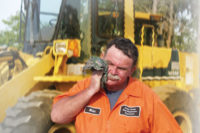It can happen to anyone — and everyone reacts to it differently.
In the workplace, heat exposure can quickly become your number one enemy, leading to dangerous stress disorders.
According to OSHA, every year, thousands of workers become sick from occupational heat exposure, and some even die. Yet heat is often overlooked as a root cause of injuries and death in the workplace. A number of environments can expose workers to high levels of heat, which makes it critical that all workers recognize the potential dangers of heat in their work area.
| New workers and those returning from time away are especially vulnerable. |
When summer gets into full swing here in the United States, there is a rise in occupations that more often than not involve being outside in the sun, including construction work, painting and roofing, maintenance and landscaping services, agricultural jobs, and even positions like a camp counselor, amusement park attendant or coach.
Year-round indoor jobs, such as bakeries, commercial kitchens, laundries and factory work, all involve working in a hot environment as well and can lead to risk and injury. However, with the seasonal work of outdoor jobs, ensuring workers understand the proper training, control measures, and safe work practices will help to maintain health and safety on the job.
Heat-related illnesses and injuries
Working operations, like the ones listed above, involve exposure to high air temperatures, radiant heat sources, high humidity, direct physical contact with hot objects, or strenuous activities and pose a high risk for heat stress-related safety and health hazards. New workers and those returning from time away are especially vulnerable. As one works, the body builds up heat generated by muscle movements and the heat from the environment, causing the core temperature to rise along with the heart rate. When the body’s normal core temperature of 98.6 degrees Fahrenheit, 37 degrees Celsius, increases even a few degrees, a worker’s mental ability can be affected. This exposure can lead to a number of occupational illnesses and injuries:
- Heat stroke
- Fainting
- Heat Exhaustion
- Heat Cramps
- Heat Rash
To help ward off these potential problems, the body will sweat to keep cool; it is possible to perspire two to three gallons of sweat each day. But sweating is effective only if the humidity level is low enough to allow evaporation and if the fluids and salts that are lost are adequately replaced. However, this will inadvertently cause dehydration as well as become an added risk to injury that may result in sweaty palms, fogged-up safety glasses, disorientation and dizziness. Burns may also occur as a result of accidental contact with hot surfaces or steam. These accidents impair the worker from completing job tasks, as well compromise their safety and health.
What you can do
Heat-related illnesses can be prevented. Employers who are proactive in training their employees to understand heat-related risk factors and how they affect a worker’s health and safety, as well as train their teams about prevention methods, will be most successful in preventing illness and injuries. Here is a list of precautionary and proactive measures that should be taken into consideration when working in a high heat environment from a supervisor/employer perspective:
Educate and train – Under OSHA regulations, workers have the right to receive information and training about hazards and their prevention, and it is the employer’s responsibility to provide this. It is important to recognize and be able to treat the signs and symptoms of heat-related illness, such as hot, dry skin, profuse sweating, hallucinations, chills, throbbing headache, high body temperature, nausea, clammy, moist skin, pale or flushed complexion, muscle cramps, etc.
Dress for the job – Ensure your employees know how to dress appropriately for the weather conditions. In hot environments, it is best to wear cool, comfortable, and breathable clothing such as cotton. This includes a hat and sunscreen when working outdoors, as well as tinted glasses when needed.
Stay hydrated – Provide plenty of fluids while at a work site; OSHA requires employers to provide potable drinking water that is easily accessible to all employees. Additionally, it is a good idea to not wait until an employee asks for water, but to be proactive in keeping everyone hydrated.
Proper diet – Make sure your employees avoid alcoholic and caffeinated beverages or drinks with large amounts of sugar like soda. Such beverages tend to cause dehydration and will make your employees more susceptible to heat illnesses.
Avoid sun exposure – A useful tool for employers/supervisors with outdoor workers is to take a look at the heat index on any given work day, which takes both temperature and humidity into account to determine the human-perceived equivalent temperature — or how hot it feels. With a high heat index, if possible, move some tasks indoors, into the shade, or erect a shelter, and have your workers perform the heaviest work during the coolest part of the day. Additionally, OSHA has a downloadable application for mobile devices that provides the current heat index.
Know the status of your workers – A new employee or those returning to a job after time away will not be able to handle the same amount of exposure to heat as an experienced worker. Gradually increase the workload or allow more frequent breaks to help these workers build up a tolerance for hot conditions. Make sure to tell your workers that if they are feeling ill to let a supervisor know right away and to implement work/rest cycles.
Have a plan – Prepare an emergency plan in the event a heat-related illness occurs with any of your workers. If anyone at the site reports or observes signs or symptoms of heat-related illness, stop activity immediately and be prepared to apply first aid. Heat stroke is a medical emergency; contact emergency medical services if a worker shows any signs of heat stroke.
Remember, knowledge is the first step in prevention. That’s why it is important to prepare for the heat while on the job. Implement heat stress precautions and procedures into your safety strategy so your workers are aware of the dangers and know what to do an emergency — acting quickly can save lives.




